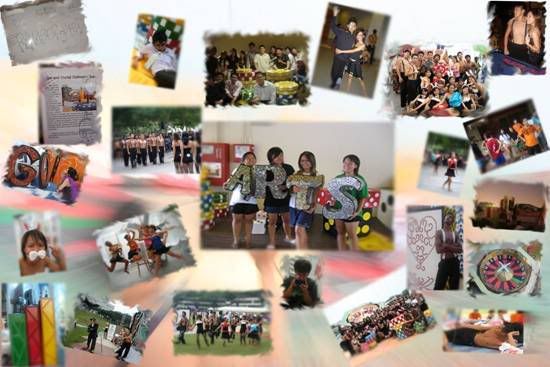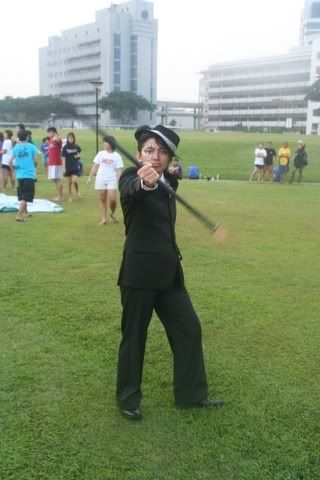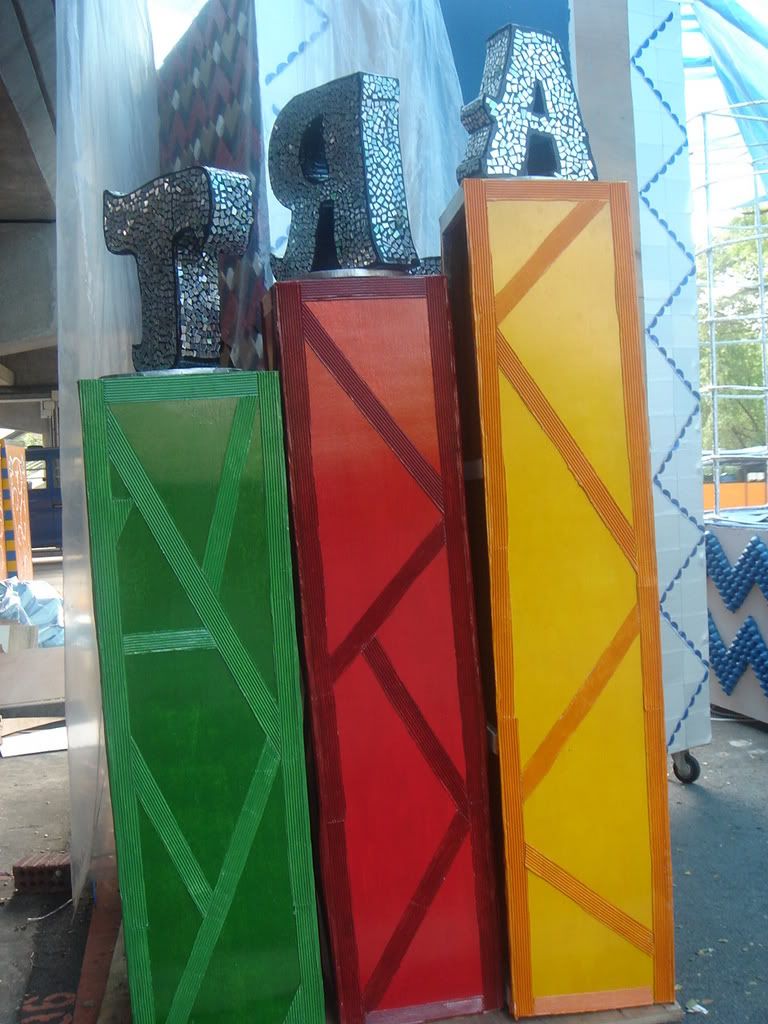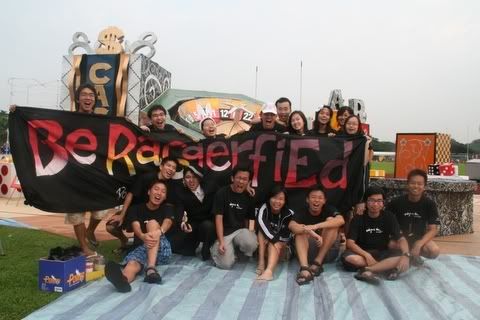Thursday, March 8, 2007
Now that the clean-up is more or less done, it's time for your resident Nature-lover to give a short summary of what raggers can expect to see and hear in and around the house. Given all the vegetation we've got around here, it's no surprise that there are quite a few birds that we don't get to see everyday; certainly more than just your usual mynahs, crows, pigeons and sparrows.Of course, one has to contend with the insects (Aargh...) Oh well, now that the washing out of decomposing cockroach fragments is done, and hopefully the scale of the mosquito assaults should lessen by now, here's hoping we'll get fewer visits from all the miscellaneous 6-legged things...
But first, a quick look at who has been creating so much misery for us during the clean-up...
(Note: All photos uploaded were not taken by me, but were instead downloaded off Google Images.)
CLEAN-UP: 26-27 May 2005

The German cockroach Blatella germanica. The other common cockroach species - This small species is actually much more common than the American cockroach, simply because its much smaller size means that infestations go undetected far longer than those of the American cockroach.
Interestingly, both species of cockroach have been wrongly named - the American cockroach did not originate from America, and the German cockroach did not come from Germany. Instead, both species are thought to have originated from Africa, and followed humans as they travelled, eventually becoming the cosmopolitan species they are today.
Household casebearer moth - caterpillars of this nondescript little moth species construct little shelters out of dirt and detritus.
The spider responsible for most of the spider webs and shrivelled-up spider corpses in the corners... the pale daddylonglegs spider Smeringopus pallidus.

Another common household spider, that often spins its little webs in corners and on ceilings - Oecobius concinnus.

If you've noticed, the walls and windows of the house were literally plastered with mud dauber wasp nests; these solitary wasps make little nests out of mud, capture and sting spiders, place them in the nests, and then seal them in alive - a fresh supply of food for the young when they hatch.
The black wasp that was buzzing around the house on the 1st day and scaring all the girls was probably a mud dauber wasp. And not to worry, mud dauber wasps and potter wasps don't sting people. Now if you see any hornets or bees around, that's a different matter...
Equally common inside the house are the nests of the potter wasps; these use live caterpillars instead of spiders. Either way, imagine being captured by a wasp, stung and paralysed, and then sealed inside a little chamber waiting for the wasp grub to hatch and eat you alive... *shudder*
And let's not forget all the geckos running all over the walls and ceilings... (and leaving all that lizard shit inside the house) Sad to say that geckos living in and around houses don't have the nice colourful patterns of their forest-living counterparts.
Spiny-tailed gecko Hemidactylus frenatus - I still remember all the lizard shit that was on the walls and windows... Not to mention the couple of shrivelled-up lizard carcasses in the cupboards and bathrooms. The spines on the tail distinguish this gecko from other species.

Indo-Pacific gecko Hemidactylus garnotii. Another common household species, the spines on the tail of this species are not as obvious as those of the spiny-tailed gecko. Interestingly, this is an all-female species; all individuals of the species are female, and they reproduce asexually (i.e. they don't have sex at all - quite a sad life if you ask me
 ).
). Four-clawed gecko Gehyra mutilata - another one of the common household gecko species. You can tell this species apart by its flatter tail, and that it has only 4 claws on its feet (as compared to 5 claws on the common house gecko). Individuals in households often appear to be completely pink or even translucent.

Flat-tailed gecko Cosymbotus platyurus. A slightly less common species, this one has the flattest tail of all. Also has more distinctive colour patterns than the other species, which are commonly just a shade of light brown or pink.
Of course, one cannot forget the resident of the garage, which we discovered (and evicted) on 27 May... Warning: Kids, don't try catching snakes with your bare hands unless you're 100% sure that the species in question is completely harmless.


Common wolf snake Lycodon capucinus - Wah lau eh, what an adventure it was catching one of these guys in the garage. (Don't worry guys, it's non-venomous and completely harmless - it feeds mostly on geckos and frogs. Too bad, if you want something to deal with rats, you'll need either cobras or pythons)
UPDATE:
Well, we evicted a snake, and now the garage has a new occupant. Ladies and gentlemen, I present to you the newest inhabitant of the garage:

Domestic huntsman spider Heteropoda venatoria. This huge spider is actually quite harmless, and does a good job of feeding on cockroaches. In any case, be careful when moving stuff around inside the garage; seeing a spider this size scurrying out from behind the planks can probably give you a heart attack.
A closer view of this huge spider. Now THAT is a big spider. This species does not spin a web, but instead wanders around, stalking large insects and even tiny geckos.
DRAIN CLEANING: 31 MAY 2005
I don't know if any of you recall how filthy and clogged up the drains were, and I finally decided to clean them out one Tuesday afternoon. What ensued was a whole lot of backbreaking work and plenty of hopping around trying to avoid all the ant nests and centipedes.
The drains were clogged with dead leaves, sand, soil, and goodness knows what else; in short, an entire ecosystem had sprung up inside the drains, not a good idea considering that this could also become a mosquito breeding haven should any water get trapped in there.
I haven't been able to positively identify all the different ant colonies I disturbed when clearing out the drains (but the bites of some of those species really really hurt), but there were at least 4 different species that called the drains their home. I suggest that we lay out ant bait just in case, and before they invade the house.
But these guys left a very lasting impression:
Weaver ants Oecophylla smaragdina - weaver ant, fire ant, kerengga... whatever you call them, the bites and stings of these ants are %$#&@^ painful! (Another reason to not run around barefoot outside; there's a colony or 2 just outside the house) As far as I know, the colony rules the little pathway that connects the main path and the back door, and I think the same colony also uses the drain along that stretch as its own little highway. I believe it's a good idea when I suggest that people refrain from running around barefoot, especially around that area.
And apart from all the ants, I managed to disturb a dozen or so of these little beasties (Do you need any more convincing as to why running around barefoot is not a good idea??!):
CENTIPEDES!
I could identify at least 2 different species...
However, while geophilomorph centipedes are pretty innocuous (haven't tried catching one with my bare hands though), I cannot guarantee the same for the other species of centipede I spotted running from the drains as I was clearing them...
Scolopendra centipede - Goodness knows how many I evicted from the drains, and those were the small ones. These species of centipedes can grow up to 30 cm in length! Singapore is home to 2 species of these large centipedes - Scolopendra morsitans and Scolopendra subspinipes.
Of course, not everything that scuttled and crawled in the drains were as bothersome as the ants and centipedes... Others just served to illustrate how bloody clogged-up and sediment-filled the drains were.

You know you have a drainage problem when you actually have earthworms living in the soil that's accumulated inside the drains. The largest one I found was almost the length (but thankfully not the diameter) of my little finger. Oh, and by the way, Jianwu is afraid of earthworms.

While clearing out the drains, I discovered a giant snail slowly crawling beside the drain. I dropped it into the drain, and watched it merrily get carried off in the current. However, there was one point when the drain ran underground, and the snail did not emerge with the flow on the other side. Only after Gerri and I had cleared out a substantial amount of the silt that had built up within did the snail pop out, and by then I guess it had drowned. Oops. My bad.
African giant snail Achatina fulica - another foreign species introduced into Singapore. Don't worry, that's not my hand. And say, anyone craving for escargot over at the house...
Every time I go to the house and see how nice and clean and dirt-free the drains are, I feel damn proud of our achievement and how we cleaned out the entire drainage system in a single day. (PLEASE help keep our drains clean!) 
While working on the float, you might be harassed by honeybees:
Eastern honeybee Apis cerana - Don't ask me why, but honeybees love to buzz around the dustbin, as well as the tap outside the house. They also like to attack people, probably to gather salt and nutrients from our sweat. They appear harmless, but don't go and ji seow them lah.
On the first day, we spotted another inhabitant of the drainage system, one that I hope does not discover all the food we have in the house:
Common rat Rattus norvegicus - One of these popped its head out of the sewer the other day... they'd better not invade the house. (Of course, it could have been any one of the many local rat species, perhaps Rattus tanezumi, Rattus exulans, Rattus tiomanicus, or Rattus annandalei; no matter what, they're all rats)
AVIFAUNA
Of course, there's so much more to the wildlife of 02 Kent Ridge Road than your usual bugs and insects, reptiles, and vermin. We've got birds! And so many different kinds too! =D
Of course, there are your usual common everyday birds, such as:
Javan myna Acridotheres javanicus - Singapore's most common bird, this immigrant from (where else?) Java is all too common.
House crow Corvus splendens - Yet another common bird... Introduced from India, they finally became established in Singapore around World War II. And now they're one of the most common birds you can find around, perhaps to the detriment of some of the native bird species. You ought to watch these in the evening, when they fly in to roost with the cockatoos... Black crows and white cockatoos, and both equally noisy. Or when they're roosting, and suddenly all the crows in the trees fly off for some unknown reason. Dozens of crows flying all over the place; anyone watched Alfed Hitchcock's The Birds?
Feral pigeon Columba livia - Hope they don't crap too much around the house... Pigeon shit is green. Absolutely disgusting...
Apart from the usual boring old birds, the Rag House has also been visited by a few other species of birds, not as common as the boring ol' mynahs, crows and pigeons, but not as rare as they may appear to be. You just need to keep your eyes (and ears) open:
House swift Apus affinis. Easily mistaken for a swallow (although swallows and swifts are not closely related), this bird spends most of its life on the wing. Another bird that has adapted well to urban life, building its little nests in buildings and other manmade structures.
House swifts sometimes gather in large flocks, especially before dusk.
Asian glossy starling Aplonis panayensis - This bird is closely related to the mynas, but slightly less common. The glossy dark green plumage and the red eyes are especially distinctive.
Olive-backed sunbird Nectarinia jugularis - Another pretty common local bird, they're damn hard to spot, since they're so damn tiny and they fly so fast.
Asian koel Eudynamys scolopacea. This is the bird responsible for that maddening call one often hears in the early morning or at dusk. Actually a species of cuckoo, it's a nest parasite of crows. Not to be confused with the Asian glossy starling or crows. This individual is a male.
The colouration of the female koel is markedly different from that of the male.
The koel once wasn't so common in Singapore; it used to be that the majority of koels in
Singapore were once migrants, and only a few koels were resident and bred here. However, it is very likely that due to the great increase in the introduced house crow population, numbers of resident koel have also risen, and thus this bird has become a much more common component of our avifauna.
Like many other members of the cuckoo family, the koel is a brood parasite - it lays its eggs in the nests of other birds, in this case, the koel specialises in the house crow and the large-billed crow. The eggs of the koel are even patterned such that they resemble the eggs of its host species. When the koel chick hatches, it competes with the crow nestlings for food, and may even push the crow eggs or nestlings out of the nest. This results in the crow foster parents feeding just one sole surviving chick - the koel chick itself.
Collared kingfisher Todirhamphus chloris - Singapore's most common kingfisher, often found far from water, since they eat lots of other things besides fish... One of these was sitting in a tree just outside the living room laughing away one day... wonder what the Hell was so funny?
White-throated kingfisher Halcyon smyrnensis. Another common local kingfisher, this species, like the collared kingfisher, is often found far from water, feeding on large insects, lizards, frogs and even smaller birds.
Black-naped oriole Oriolus chinensis - Just look out for the bright flash of yellow flying amongst the green. Very easy to spot when they fly out in the open across the road.
Pink-necked green pigeon Treron vernans - One of our native pigeon species, which feeds mainly on fruit. Actually quite common, but rarely seen.
Common flameback Dinopium javanense - Singapore's most common woodpecker species. The bright red crest of the male is unmistakeable.

Yellow-bellied prinia Prinia flaviventer. This little bird is yet another common species that is not often seen.
And of course, there are the extremely rare gems, the birds that you almost never see your entire life until you come to 02 Kent Ridge Road... true, some of these birds are not natives, but introduced or the descendants of escaped pets, but still, spotting one of these is pretty notable.

White-crested laughingthrush Garrulax leucolophus - Another introduced species that has established itself in the parks and gardens around Kent Ridge.

Large-billed crow Corvus macrorhynchos. The original native crow of Singapore. This species, while never common to begin with, has been displaced by the recently introduced house crow. Note the completely black colouration and relatively larger bill. Also, it is larger than the house crow, and much more solitary; this crow is always seen alone or in small groups, and never forms large flocks like those of the House crow.

Oriental magpie-robin Copsychus saularis - Formerly Singapore's most common bird, now very rare due to illegal capture for the songbird trade. The pair we spotted from the porch were probably escapees.


Yellow-crested cockatoo Cacatua sulphurea - The most conspicuous immigrant and now well-established resident of Kent Ridge, this Indonesian bird is popular in the pet trade. The sight of 6 or so cockatoos flying directly overhead is breathtaking - don't miss them when you're at the house. Usually, you'll hear their raucous screeching long before you hear them.
Apart from the birds, we do have a couple of mammals to look out for.
And here's an interesting snippet: Along the stretch just before KE VII Hall, right beside the road, I discovered this dead squirrel, which looked like it had slipped, fallen out of the tree, and bashed its head on a rock when it fell. Ouch... Life is cruel to the careless and unwary.
And after a hard day's work, as evening falls, as day gives way to night, you're likely to encounter these guys flying around:
Of course, this is but a tiny fraction of what one may discover living in and around the house; this post will be updated as time passes, and as new and exciting discoveries are made. But whenever you're at the house, do take time to enjoy and relax, and be grateful for the delightful change in scenery... A nature lover like me certainly appreciates the difference. Just hope the mosquitoes stop harassing us though... =P
` lets be raggerfied



























































